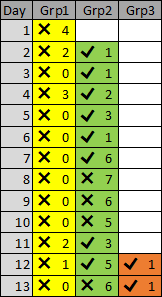Background:
I want to visualize my progress in bouldering in a nice graph.
At my lokal climbing gym boulder problems come in different colors: white -> very easy; yellow -> easy; green -> not so easy ...
Of each color there are multiple problems (approx 10). The total number varies at is also difficult to count, so I don't know it. Also counting all the problems I have solved of a given color becomes tedious as well. So I count the problems solved if that number is small or the number not solved yet if that is small.
Using this data I want to visualize my progress over time.
Basically I want to visualize data where each data point consists of multiple tuples of the following kind for each point in time:
(category, direction, value)
category has a limited number of values (approx. 5), which have a strict order. The actual values are positive integers including 0. Direction is the meaning of the value: "Number of problems solved" or "Number of problems not yet solved."
Note that there are multiple tuples at any given time. For example one might have all but 2 of the yellow problems solved and 3 green problems solved.
What would be a good way visualize this?
Sample Data (as asked for in the comments) Format: Day as integer; category; direction; value
1; yellow; not solved yet; 4
2; yellow; not solved yet; 2
green; solved; 1
3; yellow; not solved yet; 0
green; solved; 1
4; yellow; not solved yet; 3
green; solved; 2
5; yellow; not solved yet; 0
green; solved; 3
6; yellow; not solved yet; 0
green; solved; 1
7; yellow; not solved yet; 0
green; solved; 6
8; yellow; not solved yet; 0
green; not solved; 7
9; yellow; not solved yet; 0
green; not solved; 6
10; yellow; not solved yet; 0
green; not solved; 5
11; yellow; not solved yet; 2
green; solved; 3
12; yellow; not solved yet; 1
green; solved; 5
orange; solved; 1
13; yellow; not solved yet; 0
green; not solved; 6
orange: solved; 1
Properties that I think would help
I'd expect the following properties of a solution:
time goes from left to right, because that's the way I'm used to see time lines represented
higher values are displayed higher on some kind of y-axis than lower values
problems not solved values are displayed higher on some kind of y-axis then solved values, because they stand for a bigger achievement.
These are not requirements, but just things I'd expect from a solution.



